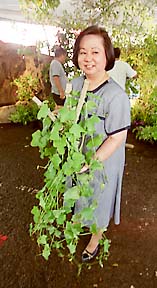


Ever Green

By Dennis Oda, Star-Bulletin
Volunteer Lance Yamasaki, left, and Hawaii Nature Center
environmental educator Atilano Jeffers-Fabro arrange elements
of the native plant forest display.
HOW do you build a pair of temporary forests in a parking lot? With a lot of work and a lot of help and a lot of confidence. Display rooted in Hawaii past
That's what Josephine Yamasaki and Atilano Jeffers-Fabro, designers of the exhibit, are finding.
Fabro is an environmental educator at Hawaii Nature Center, a contributor to the exhibit, and Yamasaki, well, Yamasaki still isn't quite sure of how she got recruited. "It started 20 years ago when a family friend, Francis Nitta, asked me to help with the educational mission of the State Farm Fair, something he has been overseeing since it started. I've been around ever since," she said.
Until this year, the educational program of the fair has consisted of workshops, talks and demonstrations given during its 10 day run, but this year it is two forests, set up in the corners of the huge exhibition tent at Aloha Stadium parking lot.
"The purpose," Yamasaki said, "'is to show people, particularly children, who walk through the exhibit what a native Hawaiian forest was and to experience the changes that occurred after the arrival of people, and see what it's like today."
HAWAIIAN FOREST DISPLAY
When: Today through Aug. 1; 6 p.m.-midnight Monday-Friday, and 11 a.m.-midnight Saturday and Sunday
Where: Hawaii State Farm Fair, Aloha Stadium parking lot
Admission to fairgrounds: Adults $2.50, children ages 5 to 12, $1.50
Call: Hawaii Farm Bureau Federation, 848-2074
To assemble the first forest of native plants, they have borrowed a collection of native plants from city, state and national resources as well as conservation groups and nurseries. Several of these plants are rare or endangered. Around the koa and ohia trees grow ferns, mosses, an endangered gardenia and other natives. A waterfall drops through the back of the exhibit, accompanied by the taped songs of native birds.
When the first Polynesians settled here to become Hawaiians, they found no edible plants, so they cut down parts of the forest to plant crops for their existence, Fabro said. "They planted taro and sweet potato to eat, wauke to make tapa, ginger and noni for medicine." They also brought pigs from the South Pacific for food.
Between the two forests, there will be exhibits, including a taro patch, interactive displays explaining how plants arrived here -- "by wind, water and wings" -- and what happened to change the environment after the arrival of Captain Cook. "The introduction of hoofed animals -- horses, cattle, goats and deer -- meant over-grazing. Their hooves compacted the roots of native plants or kicked them over." Yamasaki said.

The sandalwood industry did an enormous amount of damage to the native forests, Fabro added. "It started accidentally when fur traders from the northwest stopped here on their way to Asia to sell their furs. They picked up samples of the wood that was growing in the native forests, and took them to Asia, where sandalwood is highly prized. Suddenly it was a commercial industry for Hawaii."The ecological toll was immense. Because the chiefs and commoners were spending all their time harvesting sandalwood instead of growing crops, famine was experienced throughout the islands. When Kamehameha the Great realized the people were starving, he ordered them to tend to their crops and placed a kapu on the young trees to conserve them. But when Liholiho succeeded him, he removed restraints and trade resumed
The chiefs sometimes accepted credit for future deliveries to the traders. When they defaulted, two American warships sailed into the harbor in 1826 and demanded that $200,000, an enormous figure at the time, be paid to the traders. To raise the money, the chiefs required every able-bodied man to deliver 60 pounds of sandalwood to the government. This exhausted the supply, and historians believe the grueling work in cutting and hauling the sandalwood in the upland forests, often in wet, cold weather, was a factor in the decrease of the native population.
The whaling industry in the mid-1800s needed firewood for the shipboard process that melted whale blubber. Then came the sugar and pineapple industries, which provided jobs but wiped out lowland forests. The plantations required enormous amounts of water for the crops, and when they had depleted the artesian wells, they needed to reforest the watersheds. So in 1920, the growers mounted a huge reforestation project. "Native trees are very slow growers,'" Yamasaki said, "and they needed trees that not only would grow quickly but would adapt to different elevations. They planted eucalyptus and ironwoods, many of which are still around."
In the opposite corner from the native forest is a reproduction of the modern Hawaiian forest, with banyans, ironwoods, mango, bamboo, guava and many of the other plants found there.
With the cooperation of the agricultural departments of the state and the federal government, Fabro got a permit to display plants on the noxious weed list, the Most Wanted in horticulture crime. "We hope by showing people what miconia and clidemia and ivy gourd and the rest look like, they will recognize these plants and pull them up," he said.
In addition to the exhibits, there will be a sale of tropical plants and orchids, and because both forests will be lightly misted to keep the plants alive, the tent may be the only cool place at the fair.
Gardening Calendar in Do It Electric!
Send queries along with name and phone number to:
Evergreen by Lois Taylor, Honolulu Star-Bulletin, P.O. Box 3080, Honolulu 96802.
Or send e-mail to features@starbulletin.com.
Please be sure to include a phone number.
Evergreen by Lois Taylor is a regular Friday feature of the
Honolulu Star-Bulletin. © 1998 All rights reserved.